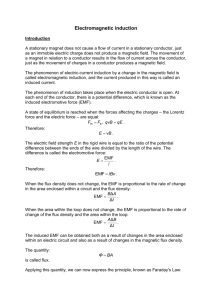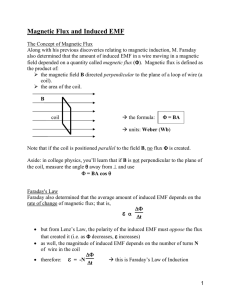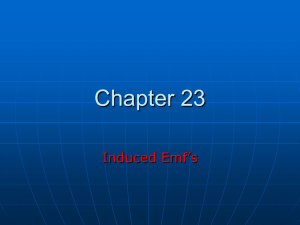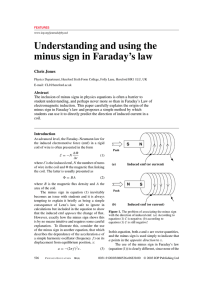Chapter 20: Electromagnetic Induction 1 PHY2054: Chapter 20
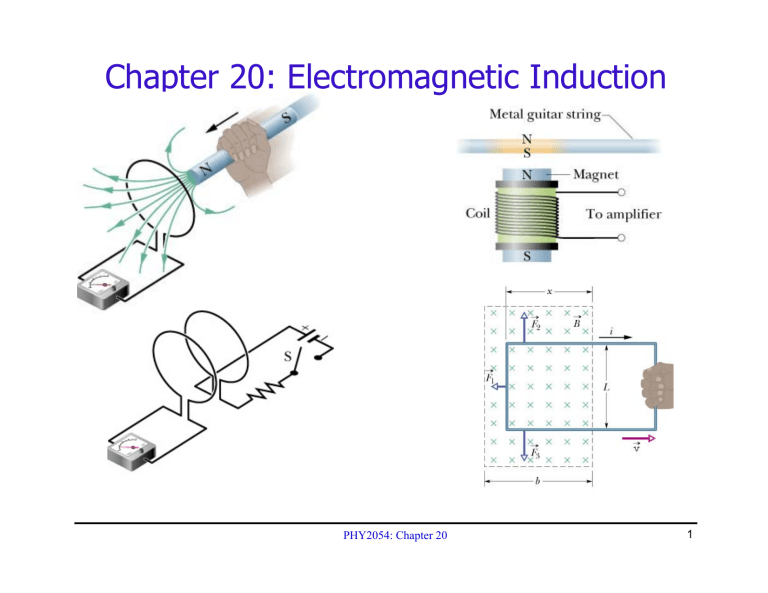
Chapter 20: Electromagnetic Induction
PHY2054: Chapter 20 1
hitt
A high voltage power line 20 m above the ground carries a current of 2 000 A. What is the magnetic field due to the current directly underneath the power line? ( µ
0
= 4 π ×
10 − 7 T ⋅ m/A) a. 20 µ T b. 35 µ T c. 14 mT d. 0.30 T
2 PHY2054: Chapter 20
Topics
Î
Electromagnetic Induction
Magnetic flux
Induced emf
Faraday’s Law
Lenz’s Law
Motional emf
Magnetic energy
Inductance
RL circuits
Generators and transformers
PHY2054: Chapter 20 3
Reading Quiz 1
Î
Magnetic flux through a wire loop depends on:
1) thickness of the wire
2) resistivity of the wire
3) geometrical layout of the wire
4) material that the wire is made of
5) none of the above
BA cos
θ Flux depends only on geometrical properties
PHY2054: Chapter 20 4
Magnetic Flux
Î
Define magnetic flux Φ
B
BA cos
θ
θ is angle between B and the normal to the plane
Flux units are T-m 2 = “webers”
Î
When B field is not constant or area is not flat
Integrate over area
Φ =
∫
A
B
⋅ d A
Won’t cover this case here
PHY2054: Chapter 20 5
BA cos
θ
0
1
2
BA
PHY2054: Chapter 20
BA
6
Experimental Observation of Induction
This effect can be quantified by Faraday’s Law
PHY2054: Chapter 20 7
Reading Quiz 2
Î
An induced emf produced in a motionless circuit is due to
1) a static (steady) magnetic field
2) a changing magnetic field
3) a strong magnetic field
4) the Earth’s magnetic field
5) a zero magnetic field
Faraday’s law
PHY2054: Chapter 20 8
Reading Quiz 3
Î
Motional emf relates to an induced emf in a conductor which is:
1) long
2) sad
3) stationary
4) insulated
5) moving
Potential difference proportional to velocity
PHY2054: Chapter 20 9
induced emf
Faraday’s Law of Induction
ε = −
N
ΔΦ
Δ t
B rate of change of flux with time number of loops
¾
The faster the change, the larger the induced emf
¾
Flux change caused by changes in either B, area, orientation
¾
Minus sign explained next slide
10 PHY2054: Chapter 20
induced emf
Faraday’s Law of Induction
ε = −
N
ΔΦ
Δ t
B rate of change of flux with time number of loops
¾
¾
Minus sign from Lenz’s Law:
Induced current produces a magnetic field which opposes the original change in flux
PHY2054: Chapter 20 11
Comment on Lenz’s Law
Î
Why does the induced current oppose the change in flux?
Î
Consider the alternative
If the induced current reinforced the change
… then the change would get bigger
… which would then induce a larger current
… and then the change would get even bigger
… and so on . . .
A clear violation of conservation of energy!!
PHY2054: Chapter 20 12
Direction of Induced Current
Bar magnet moves through coil
¾ Current induced in coil
A S N
Reverse pole
¾ Induced current changes sign
B
N S
Coil moves past fixed bar magnet
¾ Current induced in coil as in (A)
C v
S N
Bar magnet stationary inside coil
¾ No current induced in coil
PHY2054: Chapter 20
D
S N v v
13
Question
An incredible amount of electrical energy passes down the funnel of a large tornado every second. Measurements taken in Oklahoma at a distance of 9.00 km from a large tornado showed an almost constant magnetic field of 1.50
× 10 − 8 T associated with the tornado. What was the average current going down the funnel? (
T ⋅ m/A)
µ
0
= 4 π × 10 − 7 a. 450 A b. 675 A c. 950 A d. 1 500 A
B
=
μ
0 i
2
π d
14 PHY2054: Chapter 20


